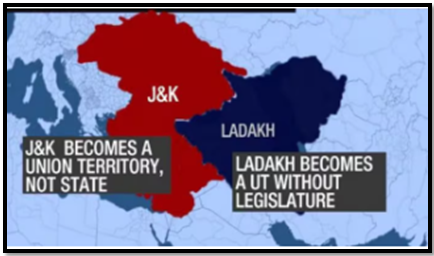A PARADOX OF PROGRESS: JAMMU AND KASHMIR AT A CROSSROADS
Syllabus:
- GS-1– Post Independent India , Asymmetric federalism , Federal form of government
Focus :
- The article analyzes the complex situation in Jammu and Kashmir, highlighting the contradictions between economic development, political alienation, and the aspirations of the people. It examines the impact of government policies, the role of local institutions, and the evolving dynamics of the region.
Source-TH
The Historical Context and Initial Sentiments
- Amir Khusrau’s Symbolism: The inscription at Srinagar’s Lal Chowk reflects a union of body and soul, symbolizing the desired integration of Kashmir with India.
- Sheikh Abdullah’s Questions: The foundational concerns about democracy, secularism, and governance in Kashmir, raised by Sheikh Abdullah in 1975, remain unresolved.
- Questions on whether the foundations of democracy and secularism are more stable, and if the distrust between Kashmiris and India has been broken, are still relevant.
Jammu & Kashmir Reorganisation Act, 2019
|
The Aftermath of Article 370’s Abrogation
- Promises vs. Reality: Union Home Minister Amit Shah had promised an end to corruption and misgovernance in Jammu and Kashmir following the abrogation of Article 370.
- However, reports from local civil rights campaigners suggest that corruption, nepotism, and misgovernance have only worsened.
- Impact on Governance and Rule of Law: The focus on counter-insurgency has compromised the rule of law, leading to widespread PTSD, even among children.
- Local governance institutions, like the District Development Councils (DDCs), have been rendered ineffective, with officials avoiding interaction with councilors and basic facilities being denied to them.
Economic and Social Discontent
- Handicraft Industry Decline: The traditional Kashmiri handicraft industry has suffered massive losses, with cheap imitations from outside the state flooding the market.
- Even local entrepreneurs find these imitations more profitable.
- Tourism Boom with Limited Local Benefits: While tourism has seen a boom, especially in Srinagar, Gulmarg, and Pahalgam, the benefits have largely bypassed the local population.
- Hotels are staffed by non-Kashmiris, and local cultural elements have been sidelined in favor of influences from other states like Gujarat and Rajasthan.
- Domicile Rules and Employment: The new domicile rules introduced by the Ministry of Home Affairs and the J&K administration have adversely impacted local employment, with many jobs being taken by migrants.
The Security Situation and Its Consequences
- Terrorism Resurgence: There has been an acceleration in terrorist activities, particularly across the Pir Panjal range in Jammu division, despite government claims of reduced militancy in the region.
- Impact on Civilian Life: The security apparatus has created an environment of fear and repression.
- Councillors face humiliation and threats, and there is widespread disillusionment among the youth, many of whom have been arrested or remain untraced.
The Democratic Process: A Ray of Hope?
- High Voter Turnout: Despite the prevailing anger and alienation, there has been a significant voter turnout in recent elections, indicating a growing realization that democratic processes, rather than violence, might offer a solution.
- Challenges to Grassroots Democracy: The establishment of the three-tier Panchayati Raj system was intended to empower grassroots democracy, but in reality, local governance bodies like the DDCs have been largely ineffective, with councillors being sidelined by the administration and security forces.
- A Newfound Hope: Despite the simmering discontent with the current political leadership, there is a burgeoning hope that the democratic process could lead to positive change.
- The people of Kashmir, although disillusioned, are beginning to see the potential in democratic engagement.
Associated Article
https://universalinstitutions.com/article-370-judgment-a-case-of-constitutional-monism/
Mains UPSC Question
GS 1
Critically examine the impact of the abrogation of Article 370 on the socio-political and economic landscape of Jammu and Kashmir. Discuss how the aspirations of the local population are being addressed in the current scenario.” (250 words)




